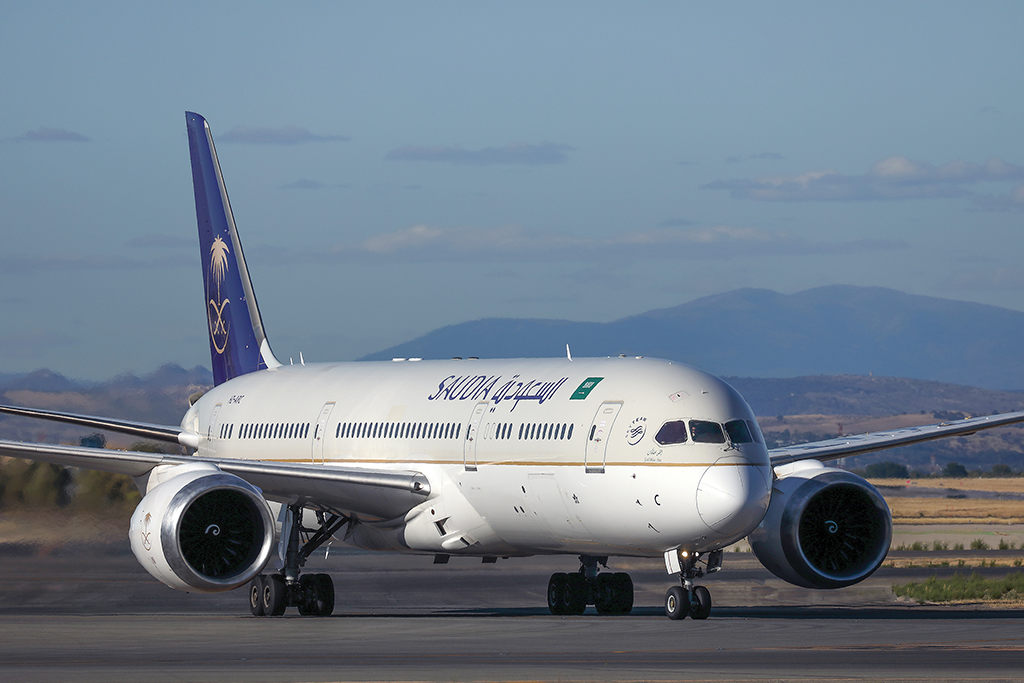
Saudi Arabian LCC flynas has an order for 120 Airbus A320neo family aircraft, including 20 A321XLRs.
To describe Saudi Arabia’s plans for its aviation sector as ambitious is something of an understatement. They include a new flag carrier, subsidies for existing carriers to expand route networks and the creation of a national leasing company. On top of that are plans for the region’s largest MRO village as well as boosting tourism numbers from 12 million today to 100 million by 2030.
These are no small or inexpensive visions, but the Arab kingdom seems set on emulating neighboring Dubai by building a complete aviation eco-system to diversify its economy away from oil and gas. And it wants to do so inside a decade.
Robert Mogielnicki, senior resident scholar at the Arab Gulf States Institute in Washington DC, said many of the projects being talked about to revitalize and diversify the Saudi economy from hydrocarbons under the country’s Vision 2030 initiative remain vague.
“It’s all targets. It’s all ambitions and conceptual,” he said.
However, the indications are that crown prince Mohammed Bin Salman Al Saud is actively involved.

“They do indicate that the transformation of the aviation sector is going to happen. It’s just a matter of when,” Mogielnicki said.
With the backing of the crown prince, the plans gain considerable heft. Added to that, the Saudi government is prepared to invest $100 billion into making it happen. It would be unwise, therefore, to dismiss Saudi Arabia’s plans as far-fetched.
The organization attempting to give form to the crown prince’s plans is the country’s Public Investment Fund (PIF). The sovereign wealth body is the backer behind the country’s first aircraft lessor, AviLease, which was announced in July and promptly signed its first deal, for the purchase and leaseback of 12 Airbus A320neos to Saudi LCC flynas.
“We fully intend to develop and attract talent to grow aviation financing expertise in Saudi Arabia,” AviLease chairman Fahad Al Saif said at the company’s opening. Al Saif is also head of the global capital finance division at PIF.
As well as purchase and leaseback deals such as that with flynas, AviLease intends to make secondary portfolio acquisitions from financial institutions, as well as place direct orders with OEMs.
New Routes
The PIF is also the driving force behind Saudi Arabia’s new Air Connectivity Program, which aims to subsidize Saudi airlines when opening up new routes. One example of this came in August, when flynas announced that it had signed an agreement with the Air Connectivity Program to launch services to Marseille, Almaty, Algiers and Casablanca. The aim, according to the official Saudi Press Agency, is to “facilitate the arrival of visitors, including tourists, pilgrims and Umrah performers, to the Kingdom.” The new flynas routes are “in line with our mandate to develop tourism air connectivity in support of the National Tourism Strategy vision and objectives,” Air Connectivity Program CEO Khalil Lamrabet said.
Domestic and regional tourism already exists. Saudi Arabia is alone in the Gulf in having the geographic size to support some 30 airports, together with a large indigenous population, which has a propensity to travel.

Additionally, Saudi Arabia attracts large numbers of religious tourists, performing Hajj and the “little pilgrimage” of Umrah, which attracts far more visitors than the better-known Hajj.
The number of religious pilgrims is planned to climb to 30 million a year by 2030 compared to around 2.5 million today. And as Saudi Arabia’s tourism facilities increase, “pilgrims will go home and return with their families,” Mogielnicki said.
However, the country is keen to shake off its staid, somewhat puritanical image and wants also to attract tourists with no religious affiliations.
“I think that, down the line, there will be some adventure tourists,” Mogielnicki said. “There will be some tourists from around the world who will want to experience something different and be among the first to visit this area. There will be some people who want to say ‘I skied in Saudi Arabia.’ There will be some windsurfers and kitesurfers who go to the Red Sea and luxury tourists prepared to pay a great deal to stay in luxury resorts on the Red Sea. [But] I do have difficulty envisaging beyond that.”
A Megacity
However, tourism is a centerpiece of Saudi Arabia’s diversification plans. New holiday resorts are being built, notably along the country’s Red Sea coast. In several cases, these will have their own airports.
Most notable will be Neom, the planned megacity in northwest Saudi Arabia. The new conurbation will be based around a 170-km-long linear city with its own airport and offshore holiday resorts. This will be so large and garner such interest worldwide, that there have been recent reports from Saudi Arabia that it will merit its own airline, flying residents, tourists and business people directly to and from it.
That idea seems fanciful, with one airline CEO pointing out that Saudi Arabia could support no more than four airlines. Current national airline Saudia, the unnamed new flag carrier, plus LCCs flyadeal and flynas (see sidebar) already make four. Another, the upscale full-service SaudiGulf, disappeared this year, while the Saudi-Egyptian venture Nesma Airlines has withdrawn from its regional network in the north of the country. So, starting a fifth would seem unwise.
A New Flagship
Of the proposed new flag carrier, little has been heard since Mohammed bin Salman al-Saud announced it in summer 2021. It is known, however, that it will be based at Riyadh, while Saudia’s main hub remains at Jeddah, the country’s commercial center. It is believed that plans for the new airline are well-advanced, with a structure and strategy scheduled to be released by the end of this year.
ATW understands that a CEO has been chosen—after several others from Europe, Asia and North America allegedly turned down the challenging role—and that the CEO’s identity will be revealed later this year. Local media reports have suggested that Tony Douglas, who stepped down as CEO of Etihad Airways Group in late 2022 and has extensive experience in the region, is the successful candidate. But he has so far not commented on his future plans.
The PIF is prepared to invest $30 billion in establishing the new flagship.
Doubts have been raised in several quarters as to why Saudi Arabia would want to create a new national airline when it already has Saudia.
“When I first heard about it, I was questioning why they would reinvent the wheel,” UK-based JLS Consulting director John Strickland said. “Saudia has a big fleet and is a known brand. They have looked, and will be looking, at the competition around them, to benchmark against Qatar Airways, Emirates and Etihad.”
However, starting a new airline from scratch will allow it to avoid ingrained work practices; and Strickland’s contacts in the region believe that a new flag carrier will be modeled much more on western lines than Saudia. He believes that a new carrier could grow, provided it has a calm, stable political environment in which to do so.
ATW understands that, contrary to initial suggestions when the new flag carrier was announced, its appearance will not mean the incumbent airline being relegated to regional and religious tourism flights.
“If you look at Vision 2030, the projected numbers in passenger growth, both in transit and in people coming to the region, mean that you could easily fill capacity on both Saudia and the new airline quite happily,” a well-placed regional source told ATW. “It won’t lead to a downgrading of Saudia; it’s well-established internationally, with more than 60 destinations in its route network.”





